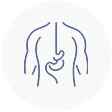General Surgery
A hernia occurs when tissues or organs bulge through a weak point in the wall of the abdomen (belly muscles). Some hernias are there at birth. Some occur after surgery. Other times, weaknesses develop in the muscles of the abdomen over time and eventually ‘give out’, causing a hernia.
Read More >>
POST HERNIA REPAIR
What to Expect
- Surgery to take about 1 hour
- Recover from anaesthesia for 1 1/2 hour before you are ready to go home
- Expect to be discharged home the day of surgery
- Pain or discomfort 5-7 days post-Op, the first two days are the toughest, but keep moving
- You will have absorbable sutures hidden under your skin
- You will have some swelling of your incision and mild bruising that can travel into the genitals. This is normal, but if your scrotum is more than twice its usual size or if you having bruising extending to your flank or upper leg call us for an early follow-up to check.
- (MEN) – Wear a jockstrap and elevate the scrotum with a towel while sitting or lying to help reduce the swelling that might occur.
- USE AN ICE PACK! Place an ice pack on top of a towel to separate your skin incision from the ice itself. Use the ice to reduce swelling for the first 48hrs after surgery.
Diet
You have no dietary restrictions after your surgery, but lots of water and high fibre foods to avoid constipation is encouraged.
Wound Care
- Unless otherwise directed, you may shower daily with your choice of soap and water to keep your incision clean and help reduce the risk of skin infection.
- DO NOT SOAK! No tubs, pools, or hot springs until you are seen at your follow-up appointment. Submerging in water increases the risk of infection.
Limitation
- DO NOT LIFT, PUSH OR PULL MORE THAN 5 kilograms or use your abdominal muscles for 6 weeks after surgery. This allows time for your incisions to heal and reduces the risk of recurrent hernia formation. The “heavy lifting” restriction is just trying to avoid abdominal strain. Do not use your abdominal muscles for 6 weeks while the hernia repair is healing.
- You should be up and moving around the night of your surgery and walking 5-6 times a day at a minimum thereafter. You will be LESS sore if you move around.
Follow Up Appointment
If you have not already done so, call our room 07 4646 3280 and schedule a post-operative visit for 2-4 weeks after your surgery.
When to Call
- Fever: Temperature greater than 101 °F
- Uncontrolled pain
- Shortness of breath – New Onset and severe call 000
- Chest Pressure or pain – New Onset and severe call 000
- Lower leg swelling
- Persistent Nausea
- Extreme bruising or swelling around the incision
- If you have other questions or concerns, call
- Use your prescription pain medication “narcotic” or “non-narcotic” as directed on the prescription.
- You may take ibuprofen 200 mg tablets: 400 mg every 8 hours and Panadol 1g every 6 hours.
- Use ice to decrease the swelling: Wrap a Ziplock bag of ice in a cloth or towel and place it on and off your incisions every 15-30 minutes as needed for the first 2 days. It will help decrease inflammation.
Bowel Care
Start bowel care IMMEDIATELY after surgery to prevent constipation. It is very common and is caused by the surgery, anaesthesia, and especially narcotics. Listed below are different options for you that are available over the counter at your local pharmacy or grocery store.
- Stool Softeners (Coloxyl & Senna) soften the stool, making it easier to pass. Stool softeners can be most effective if you drink plenty of water throughout the day.
- Our recommendation to start BEFORE the day of surgery – Coloxyl & Senna 1 tablet twice a day.
- If you develop loose stool stop the stool softeners.
Gallstones are a common problem. An operation to remove your gallbladder should result in you being free of pain and able to eat a normal diet. Gallstones are ‘stones’ that form in your gallbladder. They are common and can run in families. The risk of developing gallstones increases as you get older and if you eat a diet rich in fat. For some people gallstones can cause severe symptoms, with repeated attacks of abdominal pain being the most common.
Read More >>
A colonoscopy is a procedure during which a flexible tube, known as a colonoscope, is inserted into the anus and through the rectum so it can view the inside of the large bowel (the colon). This tube transmits images to a screen where signs of a medical condition can be seen.
Read More >>
Hemorrhoids are a common condition, affecting more than 3 million people each year. Everyone has some hemorrhoids, the cloud-like clusters of veins that lie just beneath the mucous membranes lining the lowest part of the rectum and the anus. The abnormal condition commonly known as hemorrhoids (or piles) develops when those veins become swollen and inflamed. Hemorrhoids may result from straining during bowel movements or from the severe pressure during pregnancy, among other things. Hemorrhoids may be located inside the rectum, known as internal hemorrhoids, or they may develop under the skin around the anus (external hemorrhoids).
Read More >>
Our practice offers management of acute surgical emergencies such as
• acute appendicitis
• acute Cholecystitis
• bowel obstruction
• incarcerated hernia
and many others.
Read More >>
A hemicolectomy is an operation where one section of the colon (large intestine) is removed. Some people who have this surgery may need a stoma – an opening on the surface of the tummy connected to the bowel.
The usual reasons for hemicolectomy are
• Bowel Cancer
• Polyps
• Diverticulitis
• Inflammatory Bowel Disease
• Abdominal Injury
Read More >>
WHAT CAN I EXPECT AFTER SURGERY?
There will be a mild to moderate amount of pain and discomfort associated with the surgery. This should be easily controlled with oral medications.
The discomfort and pain should begin to decrease within 48 hours after surgery. A significant increase in pain after this period should prompt you to call the office.
All incisions that are made in the skin will heal by forming a scar. Dr Bangash will always make your incision as hidden as possible.
Initially after surgery, incisions will often appear to be raised and redder than is desirable. Don’t worry, they will eventually flatten, and the redness will generally fade. However, your flap will not be completely healed for about 1 year after surgery.
Immunosuppressed patients (HIV positive, chemotherapy, AIDS etc.) and patients with certain autoimmune disorders may not be good candidates for this procedure as the risks of poor healing and infection leading to permanent scarring and poor aesthetic results may be much higher. It is mandatory that you inform Dr Bangash if you have any of these conditions before surgery.
CALL THE OFFICE PROMPTLY IF YOU NOTICE ANY OF THE FOLLOWING:
- significant increase in pain after the first 48 hours following surgery
- development of a temperature exceeding 37.8 degrees.
- the area of the incision becomes red, has purulent drainage, or is very warm to touch.
If any of the above should occur after regular office hours, do not hesitate to reach us through the answering service. For whatever reason, if you notice one of the above changes and cannot reach us at our office or through the answering service, present yourself to the emergency department for evaluation.
CALL TODAY!
HOW DO I CARE FOR MYSELF AFTER SURGERY?
Be sure to fill your prescriptions before your surgery since it means one less thing for you to worry about afterwards.
Take the antibiotics and pain medication only as prescribed by the office.
Do not take any aspirin or any anti-inflammatory compounds for 2 weeks before and 2 weeks after your surgery unless you first discuss it with your surgeon. This may not be a necessary requirement for small procedures.
If you notice some bleeding from the incision, simply apply firm pressure to the area for 15 to 20 minutes. If the bleeding persists, contact the office or answering service.
If external stitches were used during the surgery to close your incisions, do not get the area wet for 1 week after surgery. Instead, you should clean the area by rolling a Q-tip moistened (not soaked) with Saline, and then gently applying a small amount of antibiotic ointment on them. This procedure should be repeated about 4 times per day. You may purchase the ointment in any pharmacy without a prescription (Chlorsig oint). After 1 week, you should generally use a small amount of Vaseline on the incisions (after cleaning with Saline) instead of the antibiotic ointment because some people will develop a slight local skin reaction (redness) if antibiotic ointments are used for longer periods. Occasionally, Dr Bangash will ask you to use antibiotic ointments for longer than 1 week.
Do not allow drying of the incisions or crust formation. Keeping the site moist with the above procedures will hasten healing and provide you with the nicest scar possible.
Do not wear make up over the incisions or flap until the sutures are removed (or have dissolved), and a thin layer of new skin covers the area. This usually takes 7 to 10 days. You should not wear make up directly over the incision until you are told it is all right to do so by the office.
Sleeping with your head elevated for the first 48 hours may help decrease any swelling that may be noted with the surgery.
External sutures should be kept clean and dry. Dissolvable sutures will disappear on their own within 14-21 days. Non dissolvable sutures should generally be removed (unless you are told otherwise) between 7 to 14 days after the surgery. If surgical staples have been used in closing an incision in the scalp, they are often removed between 10 to 14 days after surgery. Sometimes, they will be gradually removed over a couple of visits to the office.
You can expect to experience some numbness in the area of the flap for several weeks after the surgery. Occasionally, this numbness may persist indefinitely.
Avoid exposing new surgical incisions to the sun as this may result in long-term darkening of the scar. You should apply sunscreen to the incision (SPF 15 or greater) for at least 6 months after surgery whenever you are exposed to strong sunlight.
You should generally avoid vigorous exercise or strenuous exertion such as lifting or straining for a minimum of 4-6 weeks following surgery. Sometimes, you may begin light exercise after 10 to 14 days if approved by Dr Bangash. In such a circumstance, small surgical paper tapes across the incisions may be very useful.
It is not unusual during the healing phase to note some irregularities under the skin. These small distortions will gradually subside and eventually resolve. Small bumps under the skin may be present if deep sutures were used during the surgery. These bumps will almost always flatten out as the deep sutures are dissolved by your body.
Do not massage, rub or place any tension on any of the incisions for a minimum of 4 weeks after your surgery.
If a skin graft has been used, do not disturb the dressing until you have been seen at the office.
RECOVERY TIMETABLE
Approximate healing of small facial flaps is as follows:
DAY 1 Return home, leave any surgical dressing undisturbed for first day after surgery.
DAY 2 Aching, throbbing. Start cleaning wound with hydrogen peroxide followed by application of antibiotic ointment. Repeat 4 times per day.
DAYS 7-14 Stitches removed or dissolving.
DAYS 7-14 Clean wound with Betadine followed by application of QV cream or (Papaw cream unless told otherwise by Dr. Bangash). Repeat 2 times per day. May use cover makeup.
6-12 MONTHS Red color of flap edges is going away.
1 YEAR Final result.

Aesthetic Surgery
Breast Reduction and Lift, Otoplasty, Abdominoplasty, Rhinoplasty, Liposuction, Gynecomastia and more

Reconstructive Surgery
Trauma Injuries and Chronic Wounds, Skin Cancer Removal or Repair, Management of Chronic Wounds

Breast Surgery
Oncoplastic Breast Surgery, Lumpectomy, Mastectomy, Breast Benign Disease, Sentinel Node Biopsy

Hand Surgery
Our surgeons are experienced in treating Hand Disease and Hand Trauma reconstructive procedures

General Surgery
Hernias, Gall Bladder Surgery, Colonoscopy, Gastroscopy, Thyroid Surgery, and Bowel Surgery
Not Sure What You Need?
Simply give us a call and book an appointment for yourself. Click below and contact our practice to arrange a consultation time to go through your treatment options. We are here to help.